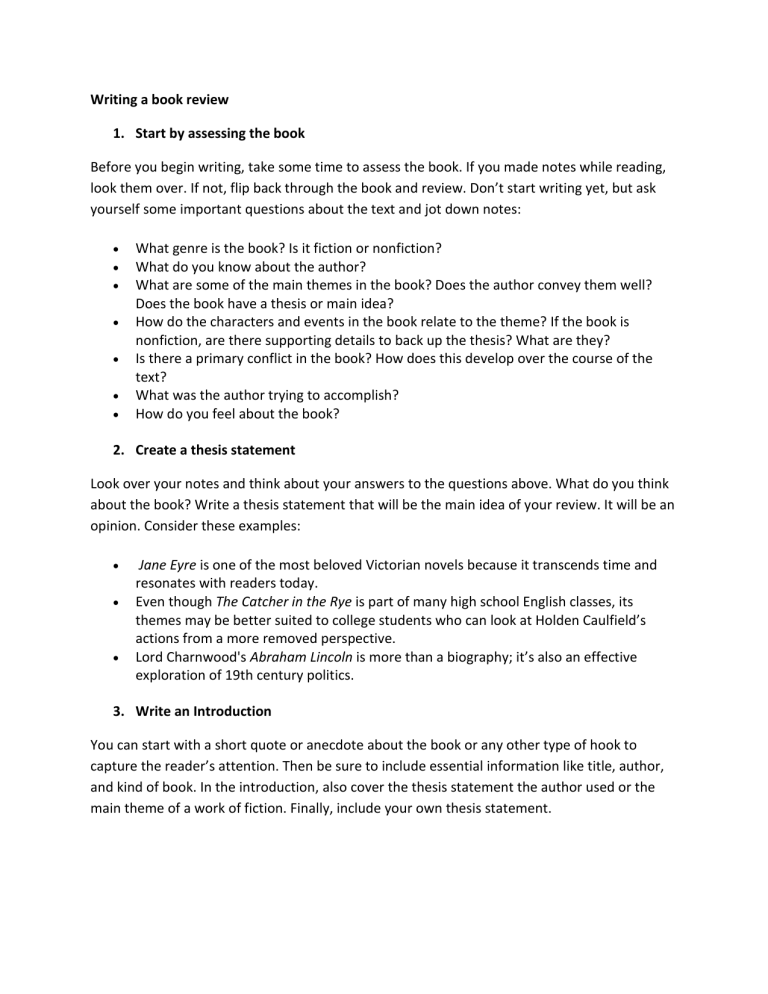
Writing a book review 1. Start by assessing the book Before you begin writing, take some time to assess the book. If you made notes while reading, look them over. If not, flip back through the book and review. Don’t start writing yet, but ask yourself some important questions about the text and jot down notes: What genre is the book? Is it fiction or nonfiction? What do you know about the author? What are some of the main themes in the book? Does the author convey them well? Does the book have a thesis or main idea? How do the characters and events in the book relate to the theme? If the book is nonfiction, are there supporting details to back up the thesis? What are they? Is there a primary conflict in the book? How does this develop over the course of the text? What was the author trying to accomplish? How do you feel about the book? 2. Create a thesis statement Look over your notes and think about your answers to the questions above. What do you think about the book? Write a thesis statement that will be the main idea of your review. It will be an opinion. Consider these examples: Jane Eyre is one of the most beloved Victorian novels because it transcends time and resonates with readers today. Even though The Catcher in the Rye is part of many high school English classes, its themes may be better suited to college students who can look at Holden Caulfield’s actions from a more removed perspective. Lord Charnwood's Abraham Lincoln is more than a biography; it’s also an effective exploration of 19th century politics. 3. Write an Introduction You can start with a short quote or anecdote about the book or any other type of hook to capture the reader’s attention. Then be sure to include essential information like title, author, and kind of book. In the introduction, also cover the thesis statement the author used or the main theme of a work of fiction. Finally, include your own thesis statement. 4. Give a Short Summary of the book Next, create a summary of the book to give your reader some background. Talk about what happens over the course of the book. This should offer context, but it’s not the main part of a book review. Keep it to one or two paragraphs unless you’re writing a very long piece. 5. Provide your Analysis Now it’s time for the main part of your book review: backing up your opinion. Your thesis statement is your own view, but you’ll need to share why you think what you do. Look to your notes here; you already have the information you need. Add details from the text, such as the point of view of the book, the characters, and the important themes. Also discuss the following as they relate to your thesis: Cover the author's style of writing and look at his or her cohesion, clarity, flow of the text, and use of precise words. Think about how you were affected by the book and if any of your opinions or feelings change because of it. Decide if the book met its goal and whether you would recommend it to others and why. Discuss the author's descriptions and narration, pointing out whether he or she explained facts or tried to persuade the readers of the validity of an issue. Analyze whether the book suited its intended audience and if it was interesting 6. End with a strong Conclusion Just like an essay, a book review needs a strong conclusion. Restate your thesis statement and summarize by touching on the main points. You may include quotes or references here, but do not put in any new information. Source: https://grammar.yourdictionary.com/style-and-usage/guide-to-writing-a-book-review.html
